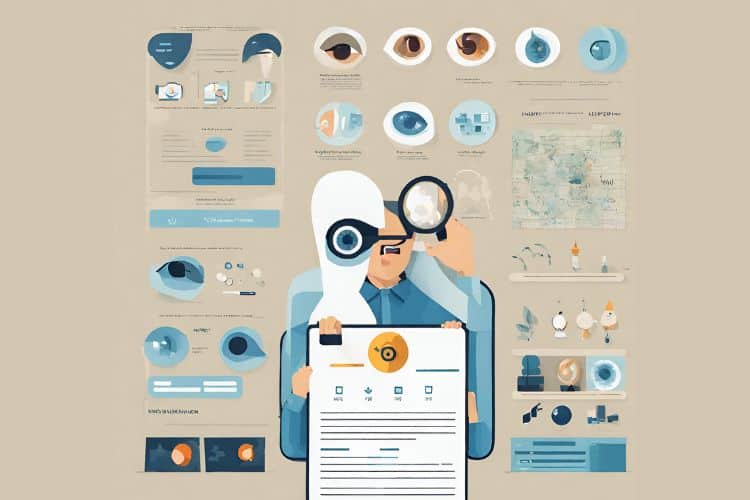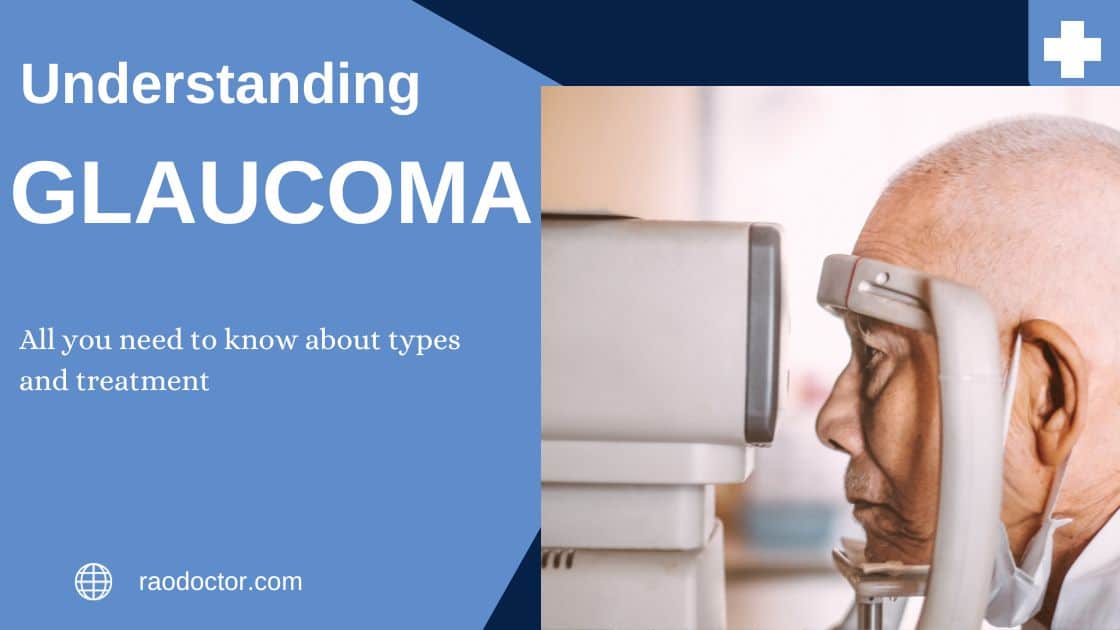Glaucoma: All You Need to Know about Types and Effective Ways to Manage Them
Glaucoma is an eye disease that can cause permanent vision loss if not managed and treated early. It is the leading cause of blindness in the world, especially among people over 60 years old.
In the recent past, I have written an article on 7 eye problems and in it one was glaucoma.
If you have risk factors for glaucoma, it’s important to get checked regularly. There are two types of glaucoma: primary open-angle glaucoma and primary angle-closed glaucoma.
Both types involve pressure buildup inside the eye that affects its ability to send clear signals to the brain by putting pressure on the Optic Nerve.
![Understanding Glaucoma: All You Need to Know about it 2 A doctor checking eye pessure known as intraocular pressure[iop] in a suspected glaucoma patient](https://raodoctor.com/wp-content/uploads/2023/11/Untitled-design-51.jpg)
Here, in this article, is everything you need to know about glaucoma, including its risk factors, symptoms, and treatments, so you can better manage and reduce your risk of developing this condition.
Why is knowing about Glaucoma important?
If glaucoma is not properly controlled and treated in its early stages, it can result in irreversible visual loss. It is the primary cause of blindness worldwide, particularly in older adults.
If you have any of the risk factors for glaucoma [discussed below], routine screenings are essential. Primary Open-Angle Glaucoma and Primary Angle-Closed Glaucoma are the two forms of glaucoma.
In both cases, the eye experiences internal pressure buildup that impairs the eye’s capacity to communicate with the brain clearly.
What is glaucoma?
Glaucoma is an eye disease that can cause permanent vision loss if not managed and treated early. It is the leading cause of blindness in the world, especially among people over 60 years old.
There are two types of glaucoma:
- Primary Open-Angle Glaucoma and
- Primary Angle Closure Glaucoma
Open-angle glaucoma and angle-closure glaucoma are the two most common forms of glaucoma. While both types affect the optic nerve and cause vision loss, they differ in their underlying causes and symptoms.
Open-angle glaucoma occurs when the drainage angle in the eye is open but becomes clogged over time, leading to increased pressure in the eye. This type of glaucoma typically develops slowly and is often asymptomatic until significant vision loss has occurred.
On the other hand, angle-closure glaucoma occurs when the drainage angle in the eye is narrow or closed, causing a sudden buildup of pressure in the eye. This type of glaucoma can cause severe symptoms such as eye pain, headache, nausea, and vomiting.
Both types involve pressure buildup inside the eye that affects its ability to send clear signals to the brain.
Open-angle glaucoma damages the part of the eye known as the “retina” that’s responsible for letting us see detail and color. A buildup of “fluid” inside the eye increases the pressure inside the eye and triggers the death of retinal cells.
A different kind of fluid, a protein-and-water mixture, accumulates and presses against the inside of the eye’s drainage system in Primary Angle Closure Glaucoma. This can cause the flow of fluid out of the eye to back up into the eye.
Suggested reading: What is Glaucoma
Primary Open-Angle Glaucoma
Open-angle glaucoma is the most common type of glaucoma. It usually develops gradually and without any early warning signs or symptoms. The condition is caused by increased pressure in the eye that damages the optic nerve and can result in blindness if left untreated.
If you have risk factors for glaucoma, it’s important to get checked regularly. Open-angle glaucoma is more common in people aged over 60, in certain ethnic groups (such as people of African or Caribbean descent), and in people with a family history of glaucoma.
Primary Angle-Closure Glaucoma
Primary angle-closure glaucoma is less common than open-angle glaucoma and is almost always found in people who have an abnormal drainage system. This can cause a build-up of fluid in the eye, which leads to increased pressure. Primary angle-closed glaucoma can also be caused by certain medications and other medical conditions.
For more on different types of glaucoma, read here: Types of Glaucoma
Read how internal eye pressure affects our eyes here:
Glaucoma and intraocular pressure (Doc) by K P Vasudeva RaoRisk Factors for Glaucoma
While anyone can develop glaucoma regardless of age, race, or gender, certain risk factors can increase your chances of developing the condition. These risk factors include:
- age (especially over 60),
- family history of glaucoma (or a family history of certain eye diseases),
- ethnicity (African, Hispanic, Asian, or Pacific Islander descent),
- diabetes, high blood pressure,
- abnormal shape of the eye,
- excessive eye pressure,
- certain eye surgeries,
- certain medications, and
- certain lifestyle habits.
Symptoms of Glaucoma
The symptoms of glaucoma can develop gradually and appear without any “signs” of their presence. If left untreated, the condition can cause blindness. The most common symptoms of glaucoma include:
- gradual vision loss (which may be perceived as blurry or hazy vision at first),
- seeing halos or bright spots around lights,
- difficulty reading, headache or pain behind the eyes,
- seeing “double” or feeling dizzy, and
- eye redness.
INVESTIGATIONS FOR GLAUCOMA
The best way to diagnose glaucoma is with a thorough eye examination. The ophthalmologist will examine your eye and may perform certain tests to rule out other conditions that may have similar symptoms to glaucoma.
A slit lamp exam is used to examine the inside of your eye. During a slit lamp exam, the ophthalmologist will dilate your pupils and shine a bright light into your eyes to see the inside of your eye.
For more information, read this:
Glaucoma and intraocular pressure (Doc) by K P Vasudeva RaoPREVENTION OF GLAUCOMA

The best way to avoid glaucoma is to reduce your risk factors for the condition. Here are 7 ways you can prevent glaucoma:
- Follow a healthy diet and exercise regularly.
- Stay away from tobacco products.
- Manage your diabetes and blood pressure.
- Get your eyes checked regularly.
- Don’t use eyedrops that contain steroids.
- Don’t overuse prescription eyedrops.
- Have regular eye exams.
Stay on top of your eye healthcare and follow up with your doctor if you notice any changes.
Treatment for Glaucoma
Treatment options for glaucoma include medicated eye drops, laser therapy, and surgery. In some cases, a combination of these treatments may be necessary to effectively manage the condition. It is important for individuals with glaucoma to receive regular eye exams and follow their treatment plan to prevent further vision loss.
Treatment for glaucoma depends on the type of glaucoma (open-angle or angle-closure) and the severity of the condition. Your ophthalmologist will recommend certain treatments based on your symptoms and risk factors. The treatment options for glaucoma include
- Medication
- Surgery
- Laser or injection therapy
- Eye Exercises
- Vision Rehabilitation
- Eye Drops
For more on treatment, please read this:
Glaucoma and intraocular pressure (Doc) by K P Vasudeva RaoConclusion
Glaucoma is an eye disease that can cause permanent vision loss if not managed and treated early. It is the leading cause of blindness in the world, especially among people over 60 years old. There are two types of glaucoma: primary open-angle glaucoma and primary angle-closed glaucoma. Both types involve pressure build up inside the eye that affects its ability to send clear signals to the brain. Open-angle glaucoma damages the part of the eye known as the “retina” that’s responsible for letting us see detail and colour, while primary angle-closed glaucoma involves a different type of fluid buildup.
Like to know more about Glaucoma? Read these articles:
- Glaucoma is no longer disease of Elevated Intraocular Pressure
- Gonioscopy
- Acute Angle Closure Glaucoma
Final words
I hope you have found this article informative and easy to understand. Do share it with others on your social media accounts-the icons are shown at the bottom of this article. Alternately, you can Click to Tweet-
Understanding Glaucoma: All You Need to Know about it Share on XMy next topic for discussion will be on a very common yet less understood ailment- Anemia.
Adios.

